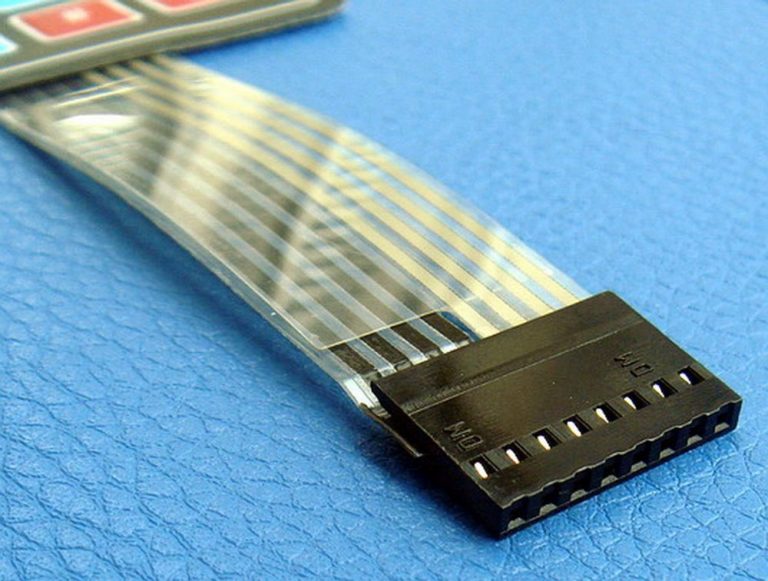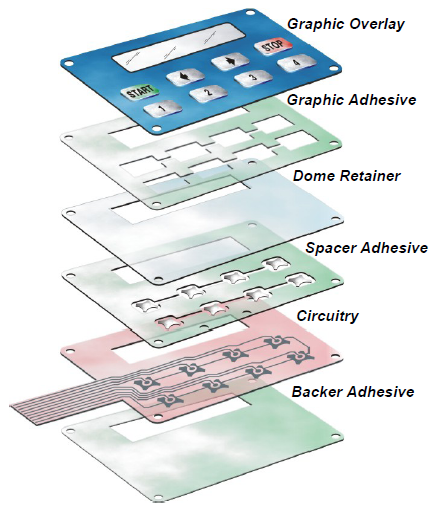Discover How Membrane Switches Function and Their Duty in Modern Electronic Devices
Membrane Switches stand for an advanced integration of technology and style within the realm of contemporary electronics, serving as vital interfaces in many devices. Comprehending the complexities of Membrane button capability and their broader effects in enhancing user experience invites additional exploration into their design, benefits, and the cutting-edge developments shaping their future in technology.
What Are Membrane Switches?

Membrane switches are differentiated by their longevity and resistance to environmental aspects, such as dirt, wetness, and severe temperature levels. They can be personalized with various graphics, shades, and responsive feedback options, enhancing individual experience while keeping aesthetic appeal - membrane switches. The consolidation of printed circuits enables for seamless assimilation right into tools, boosting general functionality.
The flexibility of Membrane buttons appears in their capacity to sustain both simple and complicated control features. They can integrate attributes such as LED indicators and touch-sensitive technology, providing to details individual requirements. As technology remains to evolve, Membrane Switches stay important for enabling intuitive and efficient interface, thus playing a crucial function in the advancement of modern-day electronic tools.
Parts of Membrane Switches
Membrane switches are made up of several vital elements that collaborate to develop a practical and dependable interface. The key aspects include the graphic overlay, glue layer, spacer layer, and conductive traces.
The graphic overlay acts as the individual interface, typically printed on an adaptable substrate such as polyester or polycarbonate. This layer not just provides aesthetic allure but additionally consists of responsive feedback, visual signs, and protective functions. Beneath the graphic overlay exists the adhesive layer, which protects the button to the tool and guarantees durability against environmental stress and anxieties.
The spacer layer is vital for maintaining the necessary space between the graphic overlay and the circuit layer. This void allows for the activation of the switch when stress is used. The conductive traces, normally made from silver or carbon, form the electrical pathways that complete the circuit when the button is involved.
In addition, a backing layer might be consisted of for architectural assistance and insulation. These elements team up effortlessly, making certain that Membrane buttons are both durable and easy to use, making them crucial in numerous modern electronic applications.
Exactly How Membrane Switches Work
How do Membrane Switches feature properly within electronic gadgets? Membrane Switches operate the concepts of pressure-sensitive innovation, using a split building and construction that consists of visuals overlays, glue layers, and conductive components. When a customer uses stress to the button, the top layer warps, enabling the conductive elements below to make contact and finish an electric circuit. This activity causes the wanted function within the tool.
The design of Membrane switches is important for their effective procedure (membrane switches). The layers are carefully crafted to supply tactile comments, toughness, and resistance to ecological elements such as moisture and dirt. The addition of domes-- tiny, elevated areas within the switch-- boosts tactile feedback, offering individuals with a noticeable click experience upon activation
Furthermore, Membrane buttons can be tailored in terms of dimension, shape, and graphics, making them suitable for numerous applications. They are typically used in control panels, medical tools, and customer electronics due to their sleek design and integrity. Overall, the effective performance of Membrane switches is essential in enhancing individual communication and making certain seamless procedure in contemporary electronic tools.

Applications in Modern Instruments
Utilizing their distinct style and performance, Membrane switches have actually become important parts in a large range of contemporary electronic gadgets. These flexible interfaces are utilized in customer electronics, industrial equipment, medical tools, and automotive controls, providing seamless user interaction.
In customer electronic devices, Membrane buttons are commonly found in appliances like microwaves, washing makers, and various other household devices, where they make it possible for instinctive control with a smooth account. Their inconspicuous layout facilitates assimilation right into small gadgets, boosting visual allure without jeopardizing performance.
In commercial applications, Membrane Switches act as control panels for machinery, using durability and resistance to rough settings. Their capacity to withstand moisture and contaminants makes them suitable for usage go to my site in production and processing sectors.
Medical devices likewise take advantage of Membrane switches, which are developed to be simple to clean and maintain, guaranteeing health in medical settings. They are typically utilized in diagnostic devices, patient tracking systems, and portable medical devices, where integrity is extremely important.
Benefits of Membrane Buttons
Among the crucial benefits of Membrane switches is their convenience, which permits them to be customized for a range of applications across numerous markets. These buttons can be developed in different sizes and shapes, fitting published here unique product needs while offering smooth integration into tools. Their thin profile allows a sleek and small style, often improving the visual appeal of digital products.
Another considerable benefit is their sturdiness - membrane switches. Membrane switches are normally immune to dust, wetness, and chemicals, making them ideal for severe settings. This strength prolongs their lifespan contrasted to conventional mechanical switches, decreasing the requirement for constant substitutes
Additionally, Membrane Switches deal cost-effectiveness. The manufacturing procedure involves printing innovations that lessen manufacturing prices, particularly for huge runs. This affordability, combined with low maintenance requirements, makes them an eye-catching option for suppliers.

Conclusion
In final thought, Membrane Switches stand for a substantial innovation in customer interface innovation within contemporary electronic devices. As the need for instinctive and resistant interfaces continues to grow, the role of Membrane buttons in forming individual experience will undoubtedly expand.
Membrane Switches stand for an innovative assimilation of modern technology and layout within the world of modern-day electronic devices, offering as necessary user interfaces in many tools.In the world of click reference contemporary electronics, Membrane Switches offer as essential parts that promote user communication with tools. As modern technology proceeds to develop, Membrane Switches stay important for making it possible for user-friendly and effective customer interfaces, thus playing a crucial role in the improvement of modern electronic gadgets.
Just how do Membrane Switches function properly within electronic devices? Generally, the reliable functioning of Membrane buttons is crucial in enhancing individual communication and making certain seamless operation in contemporary digital tools.
Comments on “Choosing the Right Membrane Switches for Your Product’s Needs”